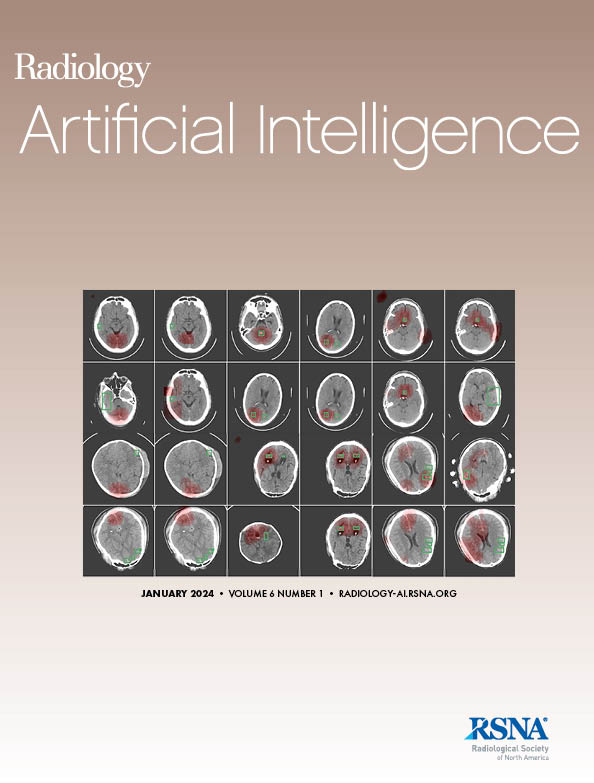Yuanji Zhang, Xin Yang, Chunya Ji, Xindi Hu, Yan Cao, Chaoyu Chen, He Sui, Binghan Li, Chaojiong Zhen, Weijun Huang, Xuedong Deng, Linliang Yin, Dong Ni
求助PDF
{"title":"实时产前颈部透明度评估的人工智能模型:高性能和工作流集成。","authors":"Yuanji Zhang, Xin Yang, Chunya Ji, Xindi Hu, Yan Cao, Chaoyu Chen, He Sui, Binghan Li, Chaojiong Zhen, Weijun Huang, Xuedong Deng, Linliang Yin, Dong Ni","doi":"10.1148/ryai.240498","DOIUrl":null,"url":null,"abstract":"<p><p>Purpose To develop and evaluate an artificial intelligence-based model for real-time nuchal translucency (NT) plane identification and measurement in prenatal US assessments. Materials and Methods In this retrospective multicenter study conducted from January 2022 to October 2023, the Automated Identification and Measurement of NT (AIM-NT) model was developed and evaluated using internal and external datasets. NT plane assessment, including identification of the NT plane and measurement of NT thickness, was independently conducted by AIM-NT and experienced radiologists, with the results subsequently audited by radiology specialists and accuracy compared between groups. To assess alignment of artificial intelligence with radiologist workflow, discrepancies between the AIM-NT model and radiologists in NT plane identification time and thickness measurements were evaluated. Results The internal dataset included a total of 3959 NT images from 3153 fetuses, and the external dataset included 267 US videos from 267 fetuses. On the internal testing dataset, AIM-NT achieved an area under the receiver operating characteristic curve of 0.92 for NT plane identification. On the external testing dataset, there was no evidence of differences between AIM-NT and radiologists in NT plane identification accuracy (88.8% vs 87.6%, <i>P</i> = .69) or NT thickness measurements on standard and nonstandard NT planes (<i>P</i> = .29 and .59). AIM-NT demonstrated high consistency with radiologists in NT plane identification time, with 1-minute discrepancies observed in 77.9% of cases, and NT thickness measurements, with a mean difference of 0.03 mm and mean absolute error of 0.22 mm (95% CI: 0.19, 0.25). Conclusion AIM-NT demonstrated high accuracy in identifying the NT plane and measuring NT thickness on prenatal US images, showing minimal discrepancies with radiologist workflow. <b>Keywords:</b> Ultrasound, Fetus, Segmentation, Feature Detection, Diagnosis, Convolutional Neural Network (CNN) <i>Supplemental material is available for this article.</i> © RSNA, 2025 See also commentary by Horii in this issue.</p>","PeriodicalId":29787,"journal":{"name":"Radiology-Artificial Intelligence","volume":" ","pages":"e240498"},"PeriodicalIF":13.2000,"publicationDate":"2025-07-01","publicationTypes":"Journal Article","fieldsOfStudy":null,"isOpenAccess":false,"openAccessPdf":"","citationCount":"0","resultStr":"{\"title\":\"Deep Learning Model for Real-Time Nuchal Translucency Assessment at Prenatal US.\",\"authors\":\"Yuanji Zhang, Xin Yang, Chunya Ji, Xindi Hu, Yan Cao, Chaoyu Chen, He Sui, Binghan Li, Chaojiong Zhen, Weijun Huang, Xuedong Deng, Linliang Yin, Dong Ni\",\"doi\":\"10.1148/ryai.240498\",\"DOIUrl\":null,\"url\":null,\"abstract\":\"<p><p>Purpose To develop and evaluate an artificial intelligence-based model for real-time nuchal translucency (NT) plane identification and measurement in prenatal US assessments. Materials and Methods In this retrospective multicenter study conducted from January 2022 to October 2023, the Automated Identification and Measurement of NT (AIM-NT) model was developed and evaluated using internal and external datasets. NT plane assessment, including identification of the NT plane and measurement of NT thickness, was independently conducted by AIM-NT and experienced radiologists, with the results subsequently audited by radiology specialists and accuracy compared between groups. To assess alignment of artificial intelligence with radiologist workflow, discrepancies between the AIM-NT model and radiologists in NT plane identification time and thickness measurements were evaluated. Results The internal dataset included a total of 3959 NT images from 3153 fetuses, and the external dataset included 267 US videos from 267 fetuses. On the internal testing dataset, AIM-NT achieved an area under the receiver operating characteristic curve of 0.92 for NT plane identification. On the external testing dataset, there was no evidence of differences between AIM-NT and radiologists in NT plane identification accuracy (88.8% vs 87.6%, <i>P</i> = .69) or NT thickness measurements on standard and nonstandard NT planes (<i>P</i> = .29 and .59). AIM-NT demonstrated high consistency with radiologists in NT plane identification time, with 1-minute discrepancies observed in 77.9% of cases, and NT thickness measurements, with a mean difference of 0.03 mm and mean absolute error of 0.22 mm (95% CI: 0.19, 0.25). Conclusion AIM-NT demonstrated high accuracy in identifying the NT plane and measuring NT thickness on prenatal US images, showing minimal discrepancies with radiologist workflow. <b>Keywords:</b> Ultrasound, Fetus, Segmentation, Feature Detection, Diagnosis, Convolutional Neural Network (CNN) <i>Supplemental material is available for this article.</i> © RSNA, 2025 See also commentary by Horii in this issue.</p>\",\"PeriodicalId\":29787,\"journal\":{\"name\":\"Radiology-Artificial Intelligence\",\"volume\":\" \",\"pages\":\"e240498\"},\"PeriodicalIF\":13.2000,\"publicationDate\":\"2025-07-01\",\"publicationTypes\":\"Journal Article\",\"fieldsOfStudy\":null,\"isOpenAccess\":false,\"openAccessPdf\":\"\",\"citationCount\":\"0\",\"resultStr\":null,\"platform\":\"Semanticscholar\",\"paperid\":null,\"PeriodicalName\":\"Radiology-Artificial Intelligence\",\"FirstCategoryId\":\"1085\",\"ListUrlMain\":\"https://doi.org/10.1148/ryai.240498\",\"RegionNum\":0,\"RegionCategory\":null,\"ArticlePicture\":[],\"TitleCN\":null,\"AbstractTextCN\":null,\"PMCID\":null,\"EPubDate\":\"\",\"PubModel\":\"\",\"JCR\":\"Q1\",\"JCRName\":\"COMPUTER SCIENCE, ARTIFICIAL INTELLIGENCE\",\"Score\":null,\"Total\":0}","platform":"Semanticscholar","paperid":null,"PeriodicalName":"Radiology-Artificial Intelligence","FirstCategoryId":"1085","ListUrlMain":"https://doi.org/10.1148/ryai.240498","RegionNum":0,"RegionCategory":null,"ArticlePicture":[],"TitleCN":null,"AbstractTextCN":null,"PMCID":null,"EPubDate":"","PubModel":"","JCR":"Q1","JCRName":"COMPUTER SCIENCE, ARTIFICIAL INTELLIGENCE","Score":null,"Total":0}
引用次数: 0
引用
批量引用

 求助内容:
求助内容: 应助结果提醒方式:
应助结果提醒方式:


